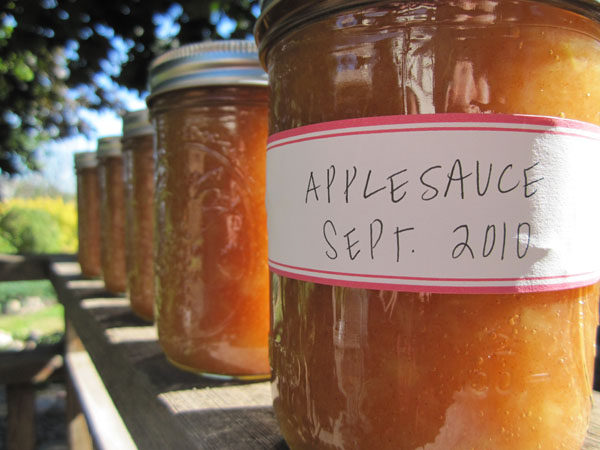
I’ve just put five jars of canned applesauce on my pantry shelf. Five jars I canned, to my immense gratification, in my own kitchen.
My grandmother’s family weathered the depression, in large part, due to the fame of my great-great-grandmother’s canned pickles. With this esteemed heritage, you’d think I would have been canning all my life. Not so! I learned to can from the Joy of Cooking, which begins with “It is a thrill to possess shelves well stocked,” but quickly moves on to cautioning against everything that could go wrong, from spilling hot water to “… Clostridium Botulinum, a germ so deadly that ‘1oz. could theoretically kill 100 million people.’”
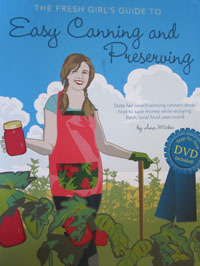
It’s a fantastic resource and this is not the first time I’ve successfully canned. But, I must admit, my pickles have been relatively few and far between, due to the paranoia that attends each attempt. There is always that nagging fear that I’ll kill myself or someone I like (canning is a long process, so one doesn’t give homemade pickles to just anyone).
In contrast, Ana Micka’s newly published The Fresh Girl’s Guide to Easy Canning and Preserving ($19.99, 128 pages and a DVD) sings a much friendlier tune. With clear instruction, a scientific approach to canning temperatures and methods, and a warm illustration style, it makes the process a whole lot less intimidating.
Why bother with canning? Micka, who hails from St. Louis Park, MN, makes it sound almost heroic. Canning is a great way to preserve in-season goodies from your CSA box, farmers market, or garden, thus ensuring that you have local fruit and veggies in the winter. Along the way, it helps reduce your carbon footprint and support the local economy. Plus, once you get rolling, putting up all that food saves money — and makes eating healthy, additive-free food as easy as opening a jar.
And yes, there is the thrill of a well-stocked pantry.
In the non-fiction book Harder than HardScrabble, Thad Sitton interviews a man who describes his depression-era childhood, explaining that his mother was forced by their circumstances to move from some Northern state to South Texas. She brought with her three Model-Ts filled with jars of canned produce — peaches, corn, and beans — essentially, a summer’s worth of dedicated gardening and her family’s food for the rest of the year.
Her cabin had no basement or root cellar, so she lined the walls of its five rooms with the food stuff. “In a few nights it come a cold spell, it wasn’t supposed to be thataway down there, and it busted them jars at night, sounded like rifles going off. I don’t remember what was the loudest sound, the fruit jars busting or my mother crying.”
That passage has stuck with me, in part because it’s heartbreaking, but also because, despite their demise, the mental image of walls and walls of glistening jars filled with fruit and vegetables is so appealing as a home cook and do-it-yourselfer.
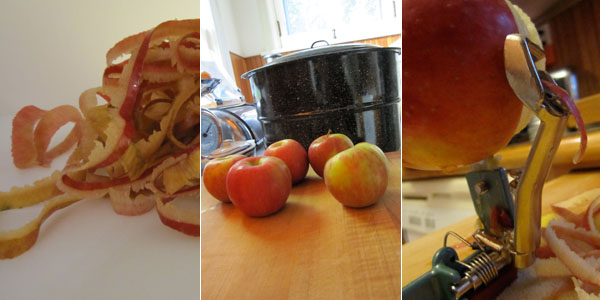
Unfortunately, according to Micka, lining even your temperature-controlled living room with canned food is not a best practice.
The Easy Canning and Preserving set is indeed a guide, providing a concise overview of how to grow your own or buy vegetables and fruit, what sort of equipment you’ll need to can, and how to do it safely (she only mentions the b word once, and death doesn’t come up in the book at all).
In both the book and the DVD, safety is divided into four easy to remember “Ss,” steps that tell you how to Sterilize your equipment, Select your canning method, Seal your jars, and Store the end product. I particularly appreciated a chart of common foods and their pH values — this is important because low acid foods must be processed in a pressure canner rather than a hot water bath. Similarly, a handy chart of what happens to both food and bacteria at various temperatures both eased my mind — facts are so great that way — and convinced me to put my glistening jars in the basement.
In the book, each canning method is described in detail and then again in illustrated steps, which will make it easier to remember each one without having to reread the entire text.
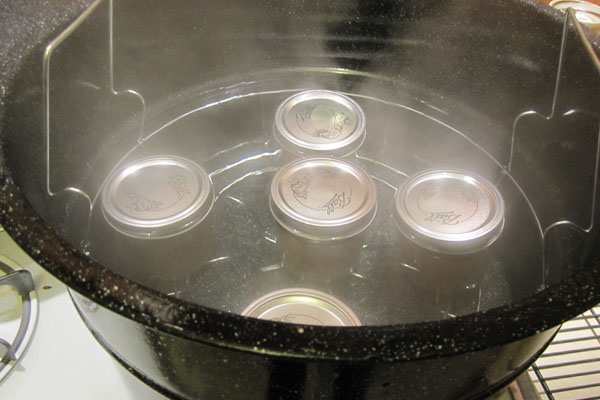
The first half of Easy Canning and Preserving is a quick read, which makes it tempting to start into the recipes that follow without watching the DVD, but that would be a mistake. One that I made when I leaped into canning applesauce! Consequently, I did not know how to remove the air bubbles from my jars — the book only mentions that one ought to use a rubber spatula, but not how exactly, so I wiggled it around in my applesauce somewhat ineffectively (well, the jars did seal). Nor did I know what to do with the five teaspoons of lemon juice listed on the ingredient list but not in the recipe.
In fact, these are are the only gaps I noticed in the book; the DVD should not be missed because it is edifying and charming. In it, local actress Leigha Horton interviews Micka and her friends — canning experts, such as MN State Fair award-winning canners Paula Pentel and Callie Wilson make an appearance — as they shop for food and equipment and demonstrate, step-by-step, how to use them, cooking various recipes from the book in the Wedge’s demo kitchen.
Micka recommends using recipes written especially for the canning process because they include processing times and how much space you should leave at the top of the jar when you seal it. Her book includes more than 75 pages of easy recipes, including everything from jam, salsa, and pickles to tikka masala, pulled pork, and winter squash.
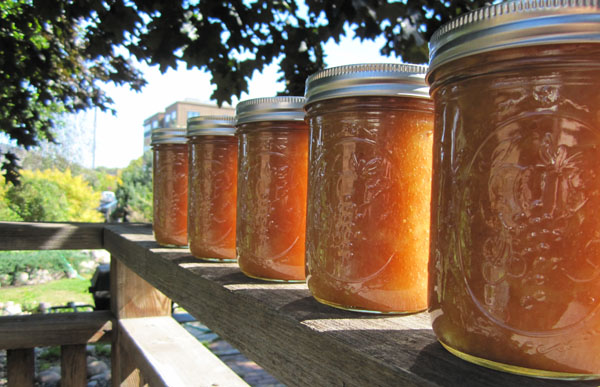
The applesauce recipe below comes from Pentel and Wilson. It is sugar free, but as the duo recommends, I combined three different varieties of apples (SweeTango, Sweet 16, and Honeycrisp) and found it apple-pie sweet and delicious.
Next time, and there will be a next time, I might balance it out with an apple that’s slightly more tart. I’ll also invite some folks over and make a day of it. That’s an awful lot of water to boil for just five cans, and without all the paranoia, canning is pretty fun.
State Fair Applesauce
Adapted from a recipe by Paula Pentel and Callie Wilson (We have included additional recipe instructions, based on the book and DVD, and edited out specific references to pages in the book.)
Makes 5 pints
24 apples (mix 2-3 different varieties if possible)
Water
1 T (15 ml) ground cinnamon (or to taste)
5 t (25 ml) lemon juice
1. Sterilize canning equipment and cooking area. Set the canner on the stove, fill it ⅔ full of water, add 2 tablespoons (30 ml) of white vinegar and bring to a boil.
2. Wash, core, and cut apples. Note: In the DVD, Pentel uses a handy food strainer. If you do not have a food strainer, simply peel the apples with a paring knife.
3. Place the apples in a heavy-bottomed, on reactive pot (stainless-steel or enamel). Add a small amount of water, about an inch (2.5 cm). Cook apples until soft, 15 to 20 minutes.
4. Strain or mash cooked apples. (If not using a food mill, mash by hand or use a blender or food processor to create desired consistency.)
5. Add cinnamon if desired.
6. Use a measuring cup or ladle and a funnel to fill jars with applesauce. Leave a ½-inch (1.3 cm) headspace at the top of the jar, topping it off with 1 teaspoon (5 ml) of lemon juice. Use a nonmetallic spatula or skewer to remove air bubbles, running it between the jar and the applesauce. Secure lid and screw ring.
7. Place jars into the canning rack and lower into boiling water in the canner. Cover, return to a boil, and process for 20 minutes, adjusting for altitude if necessary. Note: Do not start your timer until the water returns to a boil.
8. Remove jars, let cool on countertop. Test seals. Label and store in a cool, dark place for up to a year. Refrigerate any jars that haven’t sealed properly and eat within two weeks.

I am an experienced canner, but this review makes me want to check out the book anyway.
When I make applesauce I skip peeling and coring and just run the cooked apples through a food mill. The mill attachment for the KitchenAid makes it super-duper fast.
I agree with Tipper, a food mill works wonders. I canned about four gallons of applesauce the other day and it made quick work of it.
Canning definitely gets easier the more you do it. I started three years ago with a batch of pickled beets and it took me all day. But the more you do it, and learn to relax and time your tasks, it gets a whole lot easier. Now I can handle it even while taking care of my two-year-old.
It’s an addictive hobby, that’s for sure. Great story, Susan, and good luck with future canning.
This was my first canning summer and I can not tell you how satifying it was. My good friend Erin asked me to pick strawberries in June, I agreed, and she suggested that I make jam. She told me what equipment I needed, said that I should follow the recipe and instructions that come in the box of pectin and dropped me off at my apartment with a bucket full of strawberries. I’ve been going all summer. From blueberries to raspberries and tomatoes. I’m making jalapeno pepper jam this weekend. My family has been ecstatic with the results. No hobby that I have had has ever been so satisfying for me, and in turn, for my friends and family. Canning is truly addictive and really fun. Good luck Susan! And try making jam next year. Its SO easy and a true crowd pleaser.
What I love most about canning, is eating Susan’s applesauce on top of grilled pork chops! So now Susan is one more jar short, and will have to can again soon.
Hi there, I top my jars with a little lemon juice – sorry that was missed! This year I made pepper jelly using ghost peppers I grew from seed – got a 3rd place at the MN State fair! Keep up the canning.